Worksheet Solutions: Maps and Locations - 2 | Worksheets with Solutions for Class 5 PDF Download
| Table of contents |

|
| Multiple Choice Question |

|
| Fill in the Blanks |

|
| Find out from the given map. |

|
| Questions & Answers |

|
Multiple Choice Question
Q1. On a map, which direction is opposite to East?
(a) North
(b) South
(c) West
(d) East
Ans: (c) West
Q2. If you move from the top to the bottom of a map, you are moving:
(a) East
(b) West
(c) North
(d) South
Ans: (d) South
Q3. Which of these is used to show exact positions on a map?
(a) Compass
(b) Scale
(c) Grid/Coordinates
(d) Legend
Ans: (c) Grid/Coordinates
Q4. The symbol on a map that shows directions is called:
(a) Key
(b) Compass
(c) Scale
(d) Grid
Ans: (b) Compass
Q5. A map scale is used to:
(a) Show direction
(b) Show real distances in smaller form
(c) Show colors
(d) None of these
Ans: (b) Show real distances in smaller form
Fill in the Blanks
Q1. The four main directions are __________, __________, __________, and __________.
Ans: North, South, East, West
Q2. On a map, __________ is usually at the top.
Ans: North
Q3. Moving __________ on a grid means going towards East.
Ans: right
Q4. The __________ number in a coordinate pair shows the column.
Ans: first
Q5. The __________ helps in finding directions on a map.
Ans: compass
Q6. A __________ helps to measure real distances in a smaller form.
Ans: map scale
Find out from the given map.

(i) Which of these are nearest to River Yamuna?
Ans: The nearest buildings to the River Yamuna are Moti Masjid and Diwan-i-Khas. These buildings are located on the eastern side of the Red Fort, close to the river.
(ii) Which is in between the two buildings Hammam and Rang Mahal?
Ans: The building in between Hammam and Rang Mahal is the Aram Gah. It is situated between these two structures.
(iii) Which building do you pass while going from Rang Mahal to the Hammam?
Ans: While going from Rang Mahal to the Hammam, you pass by the Aram Gah. The Aram Gah is located directly in the path between these two buildings.
(iv) Which building on this map is farthest from Meena Bazar?
Ans: The building farthest from Meena Bazar is the Moti Masjid. It is located on the northeastern side of the Red Fort, whereas Meena Bazar is closer to the southwestern gate, Lahori Gate.
Questions & Answers
(i) What is the opposite direction of NORTH?
Ans: The opposite direction of NORTH is SOUTH.
(ii) What is the opposite direction of EAST?
Ans: The opposite direction of EAST is WEST.
(iii) What is the opposite direction of SOUTH?
Ans: The opposite direction of SOUTH is NORTH.
(iv) Northern state is ____________
Ans: The northern state could vary based on the country in question. For India, a northern state is Jammu and Kashmir.
(v) Eastern state is _____________
Ans: The eastern state could vary based on the country in question. For India, an eastern state is West Bengal.
(vi) Southern state is ____________
Ans: The southern state could vary based on the country in question. For India, a southern state is Tamil Nadu.
(vii) Distance between two states is 36 cm in the map. If 1 cm = 10 km in the map, what will be the actual distance between two states?
Ans: Calculation:
Actual Distance=Map Distance×Scale
Actual Distance=36 cm×10 km/cm=360 km
The actual distance between the two states is 360 km.
(viii) Distance between two states is 24 cm in the map. If 1 cm = 20 km in the map, what will be the actual distance between two states?
Ans: Calculation:
Actual Distance=Map Distance×Scale
Actual Distance=24 cm×20 km/cm=480 km
The actual distance between the two states is 480 km.
(ix) Distance between two states is 48 cm in the map. If 1 cm = 30 km in the map, what will be the actual distance between two states?
Ans: Actual Distance=Map Distance×Scale
Actual Distance=48 cm×30 km/cm=1440 km
The actual distance between the two states is 1440 km.
FAQs on Worksheet Solutions: Maps and Locations - 2 - Worksheets with Solutions for Class 5
| 1. What are the different types of maps and their uses? |  |
| 2. How can I read and interpret a map effectively? |  |
| 3. What is the importance of maps in our daily lives? |  |
| 4. What are some common symbols found on maps, and what do they represent? |  |
| 5. How do maps influence our understanding of history and culture? |  |



















